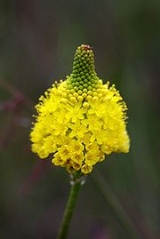
Bulbinella
Encyclopedia
Bulbinella is a genus of plant in the family Xanthorrhoeaceae
, subfamily Asphodeloideae. Most species are endemic to South Africa
, confined to the winter rainfall area with a few in New Zealand
where they are most common in the central Otago
region which enjoys a similar climate
to the Cape Region of South Africa.
of flowers, often yellow but also white, pink, yellow or orange depending on the species. In the New Zealand species only species with white and yellow flowers occur. Each flower occurs in the axil of a bract and has 1 nerved perianth
segments that are almost free. Each flower has 6 stamens. The seeds are characteristically shield shaped and there are one or two seeds in each chamber.
The plants may grow up to 1 metre in height and have narrow or thread like but never succulent leaves. The leaves decay into prominent fibres at the base of the stem, often netted or reticulate in appearance, although this feature is absent from the New Zealand species. They tend to overwinter and aestivate with wiry or swollen tuber
s.
Xanthorrhoeaceae
Xanthorrhoeaceae is the botanical name of a family of flowering plants in the order Asparagales. Such a family has been recognized by most taxonomists, but the circumscription of the family has varied wildly....
, subfamily Asphodeloideae. Most species are endemic to South Africa
South Africa
The Republic of South Africa is a country in southern Africa. Located at the southern tip of Africa, it is divided into nine provinces, with of coastline on the Atlantic and Indian oceans...
, confined to the winter rainfall area with a few in New Zealand
New Zealand
New Zealand is an island country in the south-western Pacific Ocean comprising two main landmasses and numerous smaller islands. The country is situated some east of Australia across the Tasman Sea, and roughly south of the Pacific island nations of New Caledonia, Fiji, and Tonga...
where they are most common in the central Otago
Otago
Otago is a region of New Zealand in the south of the South Island. The region covers an area of approximately making it the country's second largest region. The population of Otago is...
region which enjoys a similar climate
Climate
Climate encompasses the statistics of temperature, humidity, atmospheric pressure, wind, rainfall, atmospheric particle count and other meteorological elemental measurements in a given region over long periods...
to the Cape Region of South Africa.
Description
They are characterised by the presence of a dense terminal racemeRaceme
A raceme is a type of inflorescence that is unbranched and indeterminate and bears pedicellate flowers — flowers having short floral stalks called pedicels — along the axis. In botany, axis means a shoot, in this case one bearing the flowers. In a raceme, the oldest flowers are borne...
of flowers, often yellow but also white, pink, yellow or orange depending on the species. In the New Zealand species only species with white and yellow flowers occur. Each flower occurs in the axil of a bract and has 1 nerved perianth
Perianth
The term perianth has two similar but separate meanings in botany:* In flowering plants, the perianth are the outer, sterile whorls of a flower...
segments that are almost free. Each flower has 6 stamens. The seeds are characteristically shield shaped and there are one or two seeds in each chamber.
The plants may grow up to 1 metre in height and have narrow or thread like but never succulent leaves. The leaves decay into prominent fibres at the base of the stem, often netted or reticulate in appearance, although this feature is absent from the New Zealand species. They tend to overwinter and aestivate with wiry or swollen tuber
Tuber
Tubers are various types of modified plant structures that are enlarged to store nutrients. They are used by plants to survive the winter or dry months and provide energy and nutrients for regrowth during the next growing season and they are a means of asexual reproduction...
s.
Species
- Bulbinella angustifolia
- Bulbinella caudafelis
- Bulbinella divaginata
- Bulbinella floribunda - Yellow Cat-tail
- Bulbinella gibbsii
- Bulbinella hookeri - Maori Lily
- Bulbinella latifolia
- Bulbinella modesta
- Bulbinella nutans
- Bulbinella punctulata
- Bulbinella rossiiBulbinella rossiiBulbinella rossii, commonly known as the Ross Lily, is a species of flowering plant in genus Bulbinella. It is one of the subantarctic megaherbs...
(Hook.f.) Cheeseman - Ross Lily - Bulbinella talbotii
- Bulbinella trinervis
- Bulbinella triquetra

